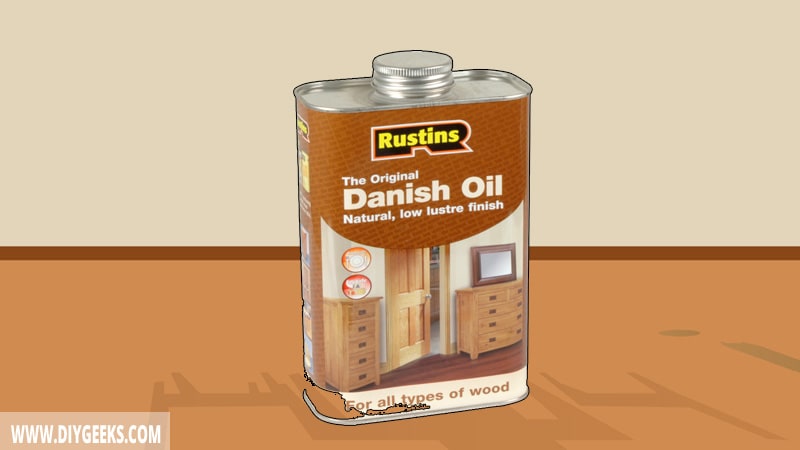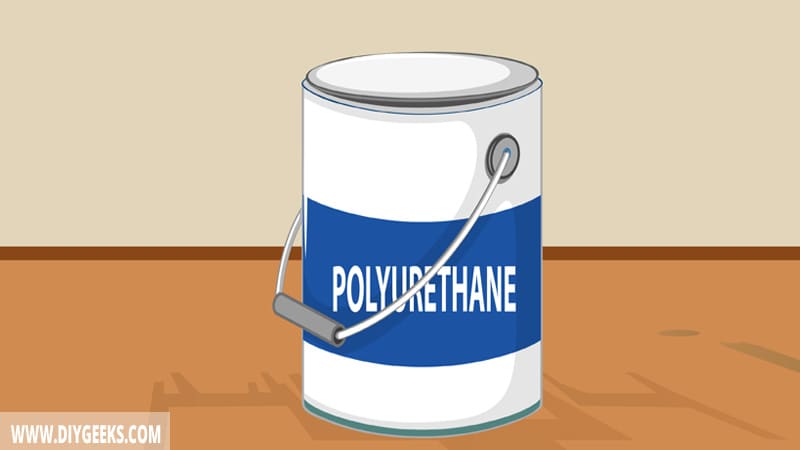Danish oil is a wood finish designed to enhance the wood’s appearance and protect it. Polyurethane is a protective coating that protects the surface from moisture, water, and scratches.
Polyurethane creates a transparent finish that offers better protection, lasts longer, and is more flexible. Danish oil offers an amber-like color shade that enhances interior wood surfaces and makes them appear darker.
What is Danish Oil?

Danish oil is a wood finish type designed to enhance the wood’s appearance and protect it. It’s a mix of different solvents and wood oils, including Linseed and Tung oil.
There’s no specific formula for Danish oil, as different products and brands include special additives and drying oils to improve the finish. You can apply it with a lint-free cloth or paintbrush.
Danish oil forms a low moisture-resistant layer (barrier) over wood and protects it from water, moisture, and scratches. It creates an amber-like color shade and makes the underlying surface appear darker.
Polyurethane

Polyurethane is a protective sealer used to protect interior and exterior surfaces from moisture, water, scratches, and weather elements. It’s obtained from the chemical reaction between polyols and isocyanate compounds.
There are two types of polyurethane; oil-based and water-based. Both have similar features, but the difference in the solvent (water and oil) makes them have different drying times and durability levels.
Polyurethane is a topical finish and doesn’t need to penetrate the surface to adhere over them — it stays over the surface top layer and dries there to form a moisture-resistant layer (barrier).
Polyurethane vs Danish Oil
The differences between polyurethane and Danish oil are listed below.
- Polyurethane creates a transparent finish that doesn’t affect the surface color shade, while Danish oil makes wood appear darker.
- Polyurethane offers better wood protection than Danish oil.
- Polyurethane lasts longer.
- You can apply both finishes with a sprayer, roller, or brush.
- Polyurethane is more versatile than Danish oil as you can apply it over interior and exterior surfaces.
- Polyurethane is easier to clean and maintain.
The Color
Polyurethane doesn’t change the underlying wood or paint color, while Danish oil makes wood appear darker.
Polyurethane has a colorless (transparent) finish that doesn’t affect the underlying surface color shade. However, oil-based polyurethane tends to yellow over time.
Danish oil creates an amber-like finish and makes the wood appear darker because it has high oils in its formula.
Wood Protection
Polyurethane protects wood better than Danish oil as it’s formulated with protective and plastic-like additives that make its finish highly moisture-resistant.
Danish oil offers low wood protection because it penetrates the surface pores deeply and doesn’t have a high layer (barrier) over the surface.
Durability
Polyurethane lasts longer than Danish oil as it’s formulated with more protective additives that protect its finish.
Polyurethane lasts between 7-10 years over a surface if applied correctly. Danish oil lasts between 2-4 years over a surface.
The Application
You can apply polyurethane with a paint sprayer, roller, or brush. You can apply Danish oil with a cloth, sprayer, or brush.
Versatility
Polyurethane is more versatile than Danish oil as you can use it over interior and exterior surfaces, such as furniture or floors.
Danish oil is less versatile as you can apply it over low-traffic indoor surfaces only.
Cleaning and Maintenance
Polyurethane is easier to clean and maintain than Danish oil because it creates a high moisture-resistant layer (barrier) that repels moisture, stains, and dust better.
Danish oil is harder to clean and maintain as it creates a soft finish that attracts stains and dust more, and requires more cleaning which can damage the finish.
The Finish
Polyurethane creates a high-gloss moisture-resistant finish that reveals the wood grain. It offers different sheen finishes — from flat (matte) to high-gloss sheens.
Danish oil creates a satin finish with a low-gloss appearance and an amber-like color shade.
Do You Need Polyurethane or Danish Oil?
Before deciding which wood finish you want, consider these:
- Wood Protection: Use polyurethane if you need better wood protection as it has a moisture-resistant layer that protects wood from moisture, water, or scratches.
- Colored Finish: Use Danish oil or tinted Polyurethane if you want a colored finish.
- Moisture Resistance: Use polyurethane If you need to protect a surface from moisture or water.
- Finished Wood: Use polyurethane over finished (or painted) wood surfaces as the sealer doesn’t need to penetrate a coating to adhere over it. Danish oil doesn’t adhere over painted surfaces as it can’t penetrate the surface pores.


